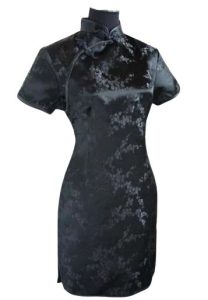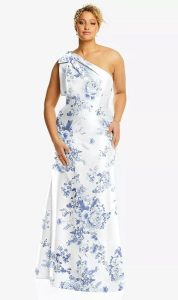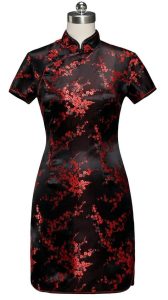The cheongsam, also known as the qipao, is a timeless garment with a rich history in Chinese fashion. This Chinese Dress for Women has evolved over centuries, reflecting cultural shifts and aesthetics. Today, the cheongsam continues to be a popular clothing choice for special occasions and everyday wear. This comprehensive guide explores the world of the chinese dress, its history, variations, and how to wear it with style.
A History of the Chinese Dress for Women
The cheongsam traces its roots back to the Qing Dynasty (1644-1912). Early versions were loose-fitting robes worn by both men and women. Over time, the cheongsam for women gradually evolved into a more fitted silhouette, reaching its peak of popularity in the 1920s and 1930s. During this era, the cheongsam became a symbol of modernization and women’s liberation in China.
The Cheongsam Silhouette
The cheongsam is characterized by its unique silhouette. Here are some key features:
-
Fitted Bodice: The cheongsam typically hugs the curves of the upper body, accentuating the waist.
-
Mandarin Collar: The mandarin collar is a short standing collar that adds a touch of elegance to the dress.
-
Side Slits: Cheongsams often feature side slits at the thigh or knee for ease of movement.
-
Varying Lengths: Cheongsams can come in a variety of lengths, from mini to maxi.
-
Vibrant Colors and Patterns: Cheongsams are traditionally made from silk or brocade fabrics and come in a wide range of colors and patterns. Popular motifs include florals, dragons, and paisleys.
The cheongsam’s silhouette and design elements can vary depending on the era and regional styles.

Types of Cheongsams
The cheongsam has evolved into a variety of styles to suit different tastes and occasions. Here are some popular variations:
Classic Cheongsam:
This features the traditional fitted silhouette with a mandarin collar and side slits. It’s a versatile option for both formal and semi-formal events.
Wedding Cheongsam:
Wedding cheongsams are often made from luxurious fabrics like red silk and embellished with intricate embroidery or beadwork.
Casual Cheongsam:
Casual cheongsams are made from lighter fabrics like cotton or linen and may have a looser fit. These are perfect for everyday wear.
Modern Cheongsam:
Modern cheongsam designers experiment with new fabrics, silhouettes, and lengths. You can find modern cheongsams with asymmetrical cuts, bold prints, or even made from unconventional materials like denim.
With so many variations available, there’s a cheongsam style to suit every woman’s taste.

Wearing the Cheongsam with Style
The cheongsam is a beautiful garment, but it’s important to know how to style it for a flattering look. Here are some tips:
-
Consider your body type: The cheongsam’s fitted silhouette can be very flattering, but it’s important to choose a chinese dress that complements your body type. For example, women with pear-shaped figures may want to choose a cheongsam with a slightly flared skirt.
-
Choose the right undergarments: A well-fitting cheongsam requires seamless undergarments to avoid visible lines.
-
Accessorize wisely: Keep accessories simple and elegant. Pearl earrings, a jade pendant necklace, or delicate bracelets can complement the cheongsam beautifully.
-
Hairstyle and Makeup: For a classic look, opt for a sleek updo or gentle waves. Makeup can be natural or slightly bolder, depending on the occasion.
By following these tips, you can ensure you look and feel your best in a cheongsam.
The Cheongsam: A Cultural Treasure
The cheongsam is more than just a dress; it’s a cultural treasure that embodies tradition and style. Whether you choose a classic or modern variation, the cheongsam is a guaranteed conversation starter and a way to connect with Chinese heritage.

The Enduring Allure of the Cheongsam
The cheongsam’s popularity continues to this day, both within China and around the world. Here are some reasons for its enduring allure:
- Versatility: The cheongsam can be dressed up or down, making it suitable for a variety of occasions.
- Cultural Significance: The cheongsam remains a symbol of Chinese culture and heritage.
- Flattering Silhouette: The cheongsam’s fitted silhouette can be very flattering for many body types.
- Wide Range of Styles: With so many variations available, there’s a cheongsam to suit every taste and style.
Cheongsams in Popular Culture
The cheongsam has also been featured in popular culture, further solidifying its place in fashion history. Here are some examples:
- Movies: Cheongsams have been prominently featured in films like “Crouching Tiger, Hidden Dragon” and “Crazy Rich Asians.”
- Fashion Designers: Many contemporary fashion designers have incorporated cheongsam elements into their collections.
These pop culture references have helped to introduce the cheongsam to a wider audience and inspire new interpretations of this classic garment.

Where to Find a Cheongsam
If you’re interested in adding a chinese dress to your wardrobe, here are some places to start your search:
- Department stores: Many larger department stores carry a selection of cheongsams, particularly around Chinese holidays like New Year.
- Online retailers: There are many online retailers specializing in Chinese clothing, including cheongsams.
- Tailors: A tailor can create a custom-made cheongsam that perfectly fits your body and style.
- Vintage stores: Vintage stores can be a great place to find unique and pre-loved cheongsams.
With a little planning, you can find the perfect cheongsam to add a touch of Chinese elegance to your wardrobe.
The cheongsam is a timeless and elegant garment with a rich history. Whether you’re looking for a special occasion dress or a unique addition to your wardrobe, the cheongsam is a beautiful option to consider. So, explore the different styles, embrace the cultural significance, and discover the enduring allure of the cheongsam.

The Cheongsam: Beyond the Dress
The cheongsam’s influence extends beyond fashion. Here are some ways the cheongsam motif appears in other areas:
-
Architecture: The rooflines of some traditional Chinese buildings echo the shape of the cheongsam’s collar.
-
Art and Design: The cheongsam’s silhouette and patterns are often depicted in Chinese paintings and decorative arts.
-
Performance: Cheongsams are frequently worn by performers in traditional Chinese operas and dance routines.
The cheongsam’s enduring presence in these cultural spheres highlights its significance as a symbol of Chinese heritage.
The Evolution of the Cheongsam
The cheongsam has continuously evolved throughout history. Here are some interesting facts about its development:
-
The Rise of the Silhouette: The shift towards a more fitted silhouette in the early 20th century reflected the influence of Western fashion on Chinese clothing.
-
Symbolic Colors: During the Qing Dynasty, specific colors were reserved for royalty. Yellow cheongsams, for instance, were exclusive to the emperor and his family.
-
Modern Interpretations: Today, designers are reimagining the cheongsam using unconventional materials and contemporary cuts, keeping the tradition alive for modern audiences.
By understanding the cheongsam’s evolution, we gain a deeper appreciation for its enduring legacy.
